Analysis of UK Business Law: Sources, Company Law and Case Suggestions
VerifiedAdded on 2023/06/05
|11
|4080
|154
Report
AI Summary
This report provides an overview of business law in the UK, detailing the various sources of law, including legislation, common law, European Union law, and the European Convention of Human Rights. It explains the procedure for framing laws and defines the intent of statutory and common law within UK courtrooms, using the R vs. Harris case as an example. The report further elaborates on company law, employment law, and contract law, outlining their key provisions and regulatory functions. It also describes the legal formation of different organizations such as sole proprietorships and partnerships, including registration requirements and liabilities. Finally, the report provides recommendations for case laws related to business law, offering insights into legal problem-solving. Desklib offers a variety of resources, including solved assignments and past papers, to support students studying business law.
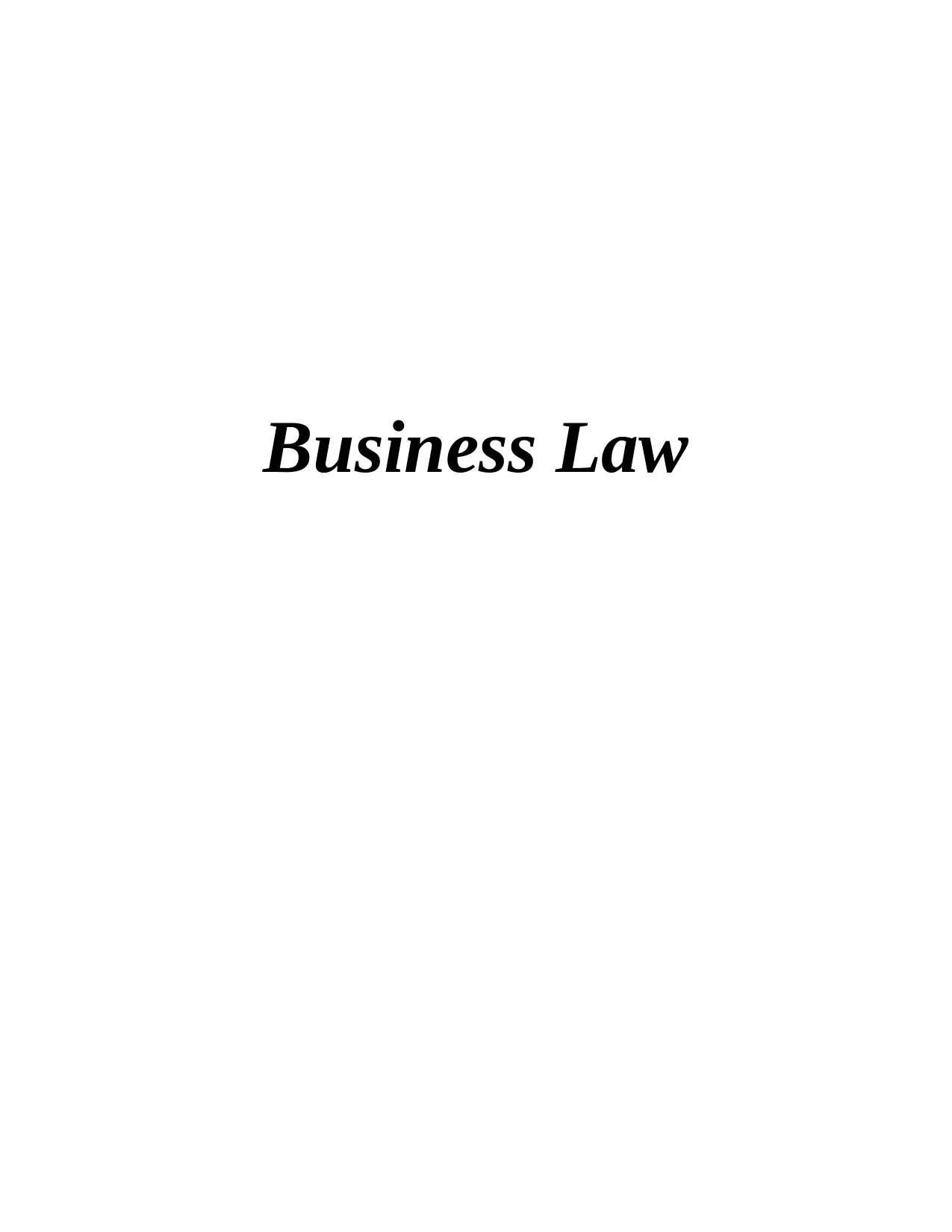
Business Law
Paraphrase This Document
Need a fresh take? Get an instant paraphrase of this document with our AI Paraphraser
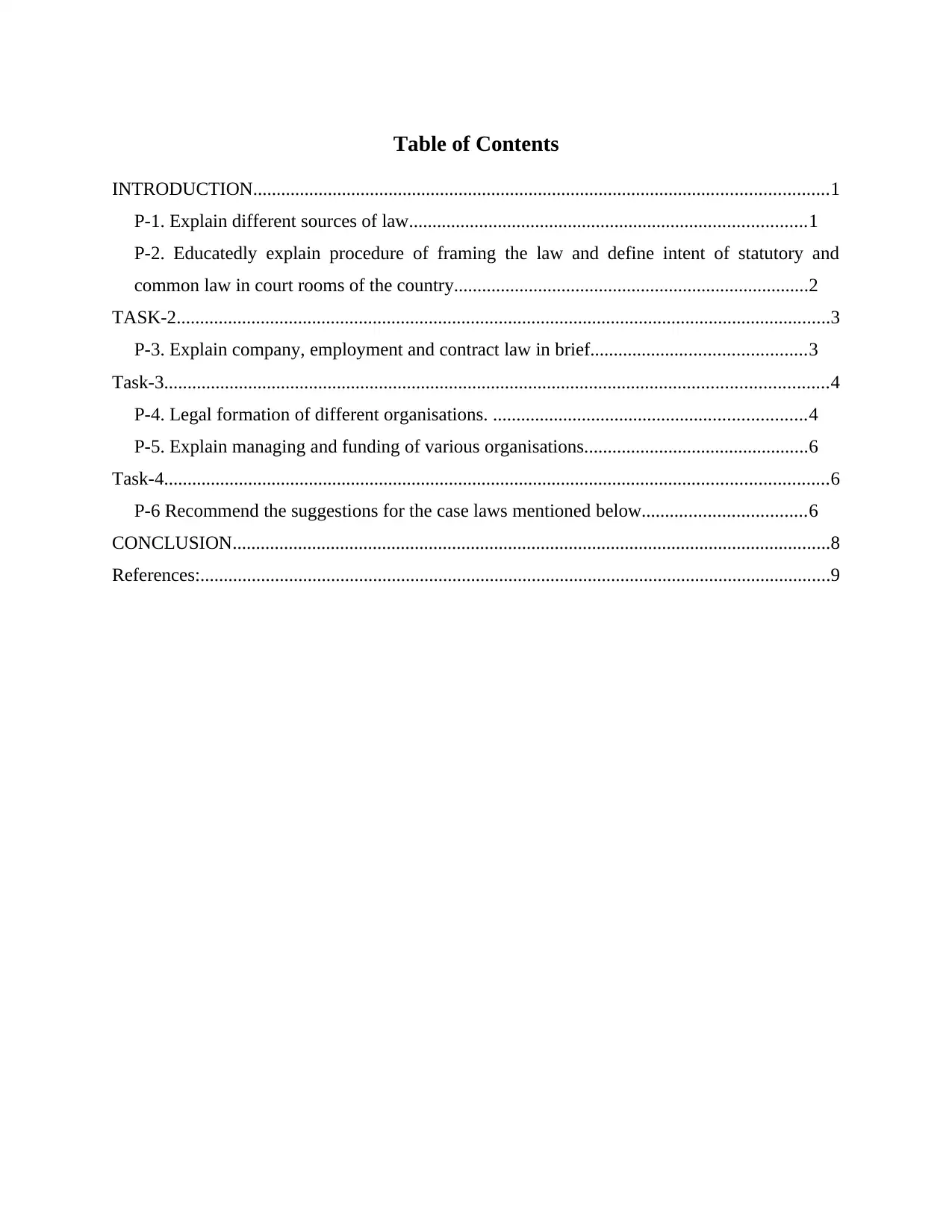
Table of Contents
INTRODUCTION...........................................................................................................................1
P-1. Explain different sources of law.....................................................................................1
P-2. Educatedly explain procedure of framing the law and define intent of statutory and
common law in court rooms of the country............................................................................2
TASK-2............................................................................................................................................3
P-3. Explain company, employment and contract law in brief..............................................3
Task-3..............................................................................................................................................4
P-4. Legal formation of different organisations. ...................................................................4
P-5. Explain managing and funding of various organisations................................................6
Task-4..............................................................................................................................................6
P-6 Recommend the suggestions for the case laws mentioned below...................................6
CONCLUSION................................................................................................................................8
References:.......................................................................................................................................9
INTRODUCTION...........................................................................................................................1
P-1. Explain different sources of law.....................................................................................1
P-2. Educatedly explain procedure of framing the law and define intent of statutory and
common law in court rooms of the country............................................................................2
TASK-2............................................................................................................................................3
P-3. Explain company, employment and contract law in brief..............................................3
Task-3..............................................................................................................................................4
P-4. Legal formation of different organisations. ...................................................................4
P-5. Explain managing and funding of various organisations................................................6
Task-4..............................................................................................................................................6
P-6 Recommend the suggestions for the case laws mentioned below...................................6
CONCLUSION................................................................................................................................8
References:.......................................................................................................................................9
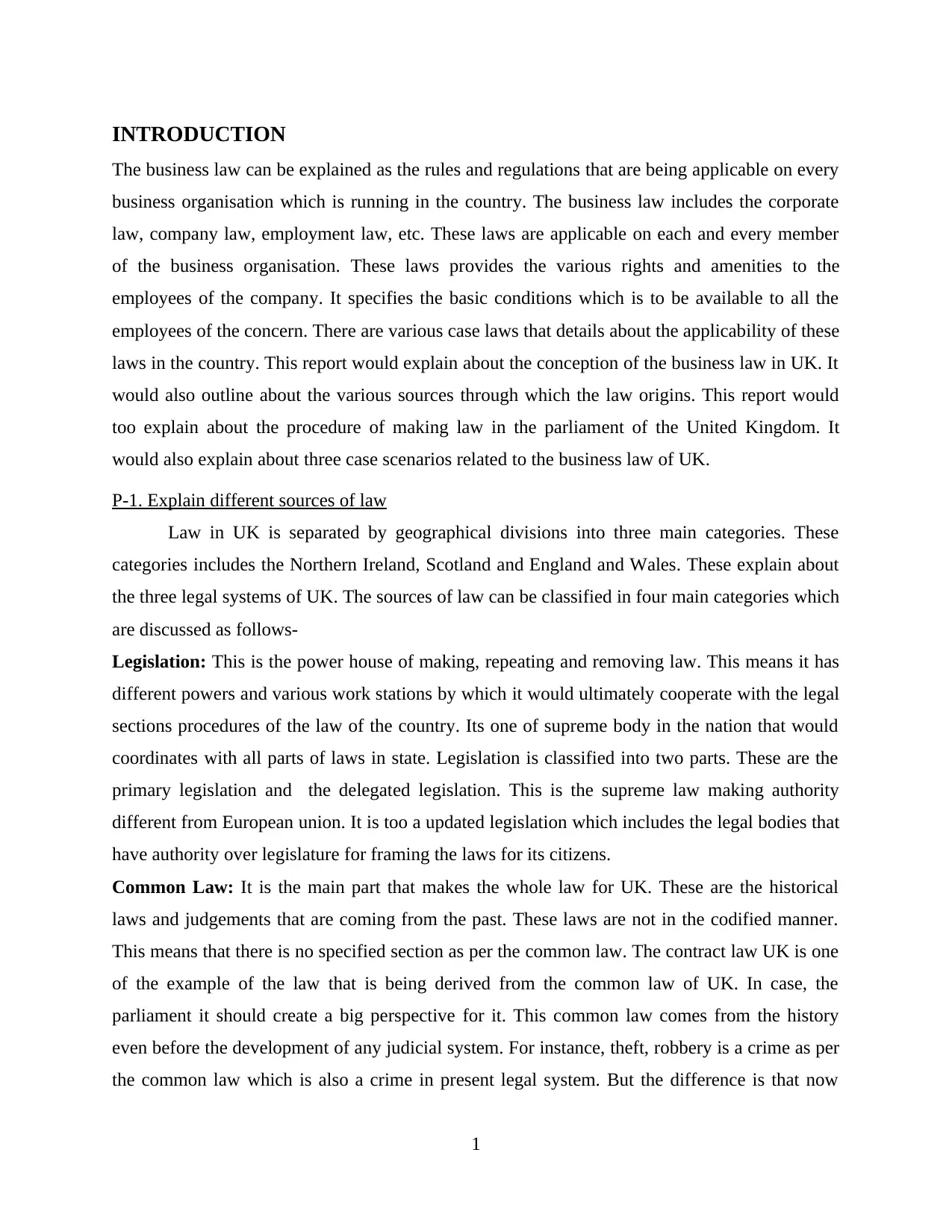
INTRODUCTION
The business law can be explained as the rules and regulations that are being applicable on every
business organisation which is running in the country. The business law includes the corporate
law, company law, employment law, etc. These laws are applicable on each and every member
of the business organisation. These laws provides the various rights and amenities to the
employees of the company. It specifies the basic conditions which is to be available to all the
employees of the concern. There are various case laws that details about the applicability of these
laws in the country. This report would explain about the conception of the business law in UK. It
would also outline about the various sources through which the law origins. This report would
too explain about the procedure of making law in the parliament of the United Kingdom. It
would also explain about three case scenarios related to the business law of UK.
P-1. Explain different sources of law
Law in UK is separated by geographical divisions into three main categories. These
categories includes the Northern Ireland, Scotland and England and Wales. These explain about
the three legal systems of UK. The sources of law can be classified in four main categories which
are discussed as follows-
Legislation: This is the power house of making, repeating and removing law. This means it has
different powers and various work stations by which it would ultimately cooperate with the legal
sections procedures of the law of the country. Its one of supreme body in the nation that would
coordinates with all parts of laws in state. Legislation is classified into two parts. These are the
primary legislation and the delegated legislation. This is the supreme law making authority
different from European union. It is too a updated legislation which includes the legal bodies that
have authority over legislature for framing the laws for its citizens.
Common Law: It is the main part that makes the whole law for UK. These are the historical
laws and judgements that are coming from the past. These laws are not in the codified manner.
This means that there is no specified section as per the common law. The contract law UK is one
of the example of the law that is being derived from the common law of UK. In case, the
parliament it should create a big perspective for it. This common law comes from the history
even before the development of any judicial system. For instance, theft, robbery is a crime as per
the common law which is also a crime in present legal system. But the difference is that now
1
The business law can be explained as the rules and regulations that are being applicable on every
business organisation which is running in the country. The business law includes the corporate
law, company law, employment law, etc. These laws are applicable on each and every member
of the business organisation. These laws provides the various rights and amenities to the
employees of the company. It specifies the basic conditions which is to be available to all the
employees of the concern. There are various case laws that details about the applicability of these
laws in the country. This report would explain about the conception of the business law in UK. It
would also outline about the various sources through which the law origins. This report would
too explain about the procedure of making law in the parliament of the United Kingdom. It
would also explain about three case scenarios related to the business law of UK.
P-1. Explain different sources of law
Law in UK is separated by geographical divisions into three main categories. These
categories includes the Northern Ireland, Scotland and England and Wales. These explain about
the three legal systems of UK. The sources of law can be classified in four main categories which
are discussed as follows-
Legislation: This is the power house of making, repeating and removing law. This means it has
different powers and various work stations by which it would ultimately cooperate with the legal
sections procedures of the law of the country. Its one of supreme body in the nation that would
coordinates with all parts of laws in state. Legislation is classified into two parts. These are the
primary legislation and the delegated legislation. This is the supreme law making authority
different from European union. It is too a updated legislation which includes the legal bodies that
have authority over legislature for framing the laws for its citizens.
Common Law: It is the main part that makes the whole law for UK. These are the historical
laws and judgements that are coming from the past. These laws are not in the codified manner.
This means that there is no specified section as per the common law. The contract law UK is one
of the example of the law that is being derived from the common law of UK. In case, the
parliament it should create a big perspective for it. This common law comes from the history
even before the development of any judicial system. For instance, theft, robbery is a crime as per
the common law which is also a crime in present legal system. But the difference is that now
1
⊘ This is a preview!⊘
Do you want full access?
Subscribe today to unlock all pages.

Trusted by 1+ million students worldwide
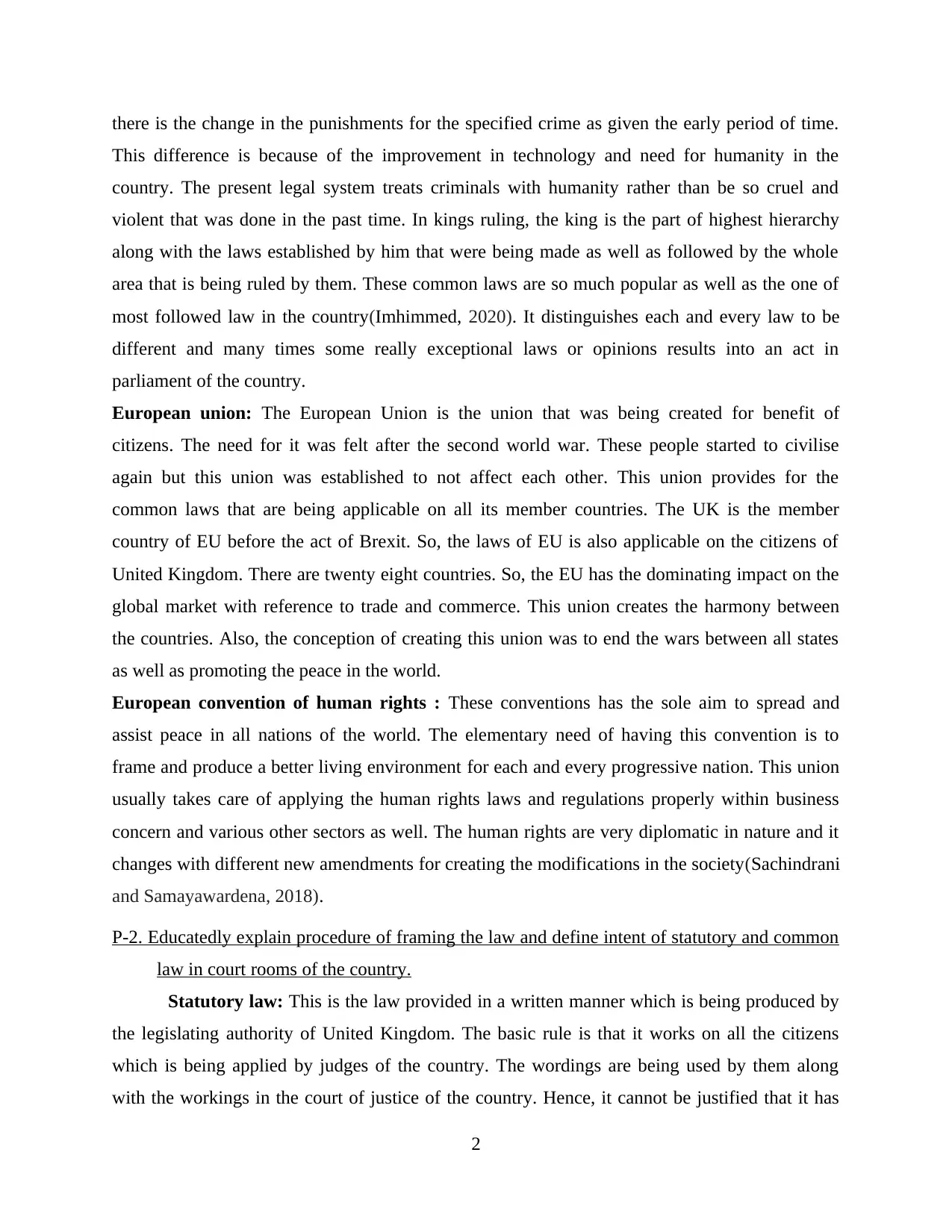
there is the change in the punishments for the specified crime as given the early period of time.
This difference is because of the improvement in technology and need for humanity in the
country. The present legal system treats criminals with humanity rather than be so cruel and
violent that was done in the past time. In kings ruling, the king is the part of highest hierarchy
along with the laws established by him that were being made as well as followed by the whole
area that is being ruled by them. These common laws are so much popular as well as the one of
most followed law in the country(Imhimmed, 2020). It distinguishes each and every law to be
different and many times some really exceptional laws or opinions results into an act in
parliament of the country.
European union: The European Union is the union that was being created for benefit of
citizens. The need for it was felt after the second world war. These people started to civilise
again but this union was established to not affect each other. This union provides for the
common laws that are being applicable on all its member countries. The UK is the member
country of EU before the act of Brexit. So, the laws of EU is also applicable on the citizens of
United Kingdom. There are twenty eight countries. So, the EU has the dominating impact on the
global market with reference to trade and commerce. This union creates the harmony between
the countries. Also, the conception of creating this union was to end the wars between all states
as well as promoting the peace in the world.
European convention of human rights : These conventions has the sole aim to spread and
assist peace in all nations of the world. The elementary need of having this convention is to
frame and produce a better living environment for each and every progressive nation. This union
usually takes care of applying the human rights laws and regulations properly within business
concern and various other sectors as well. The human rights are very diplomatic in nature and it
changes with different new amendments for creating the modifications in the society(Sachindrani
and Samayawardena, 2018).
P-2. Educatedly explain procedure of framing the law and define intent of statutory and common
law in court rooms of the country.
Statutory law: This is the law provided in a written manner which is being produced by
the legislating authority of United Kingdom. The basic rule is that it works on all the citizens
which is being applied by judges of the country. The wordings are being used by them along
with the workings in the court of justice of the country. Hence, it cannot be justified that it has
2
This difference is because of the improvement in technology and need for humanity in the
country. The present legal system treats criminals with humanity rather than be so cruel and
violent that was done in the past time. In kings ruling, the king is the part of highest hierarchy
along with the laws established by him that were being made as well as followed by the whole
area that is being ruled by them. These common laws are so much popular as well as the one of
most followed law in the country(Imhimmed, 2020). It distinguishes each and every law to be
different and many times some really exceptional laws or opinions results into an act in
parliament of the country.
European union: The European Union is the union that was being created for benefit of
citizens. The need for it was felt after the second world war. These people started to civilise
again but this union was established to not affect each other. This union provides for the
common laws that are being applicable on all its member countries. The UK is the member
country of EU before the act of Brexit. So, the laws of EU is also applicable on the citizens of
United Kingdom. There are twenty eight countries. So, the EU has the dominating impact on the
global market with reference to trade and commerce. This union creates the harmony between
the countries. Also, the conception of creating this union was to end the wars between all states
as well as promoting the peace in the world.
European convention of human rights : These conventions has the sole aim to spread and
assist peace in all nations of the world. The elementary need of having this convention is to
frame and produce a better living environment for each and every progressive nation. This union
usually takes care of applying the human rights laws and regulations properly within business
concern and various other sectors as well. The human rights are very diplomatic in nature and it
changes with different new amendments for creating the modifications in the society(Sachindrani
and Samayawardena, 2018).
P-2. Educatedly explain procedure of framing the law and define intent of statutory and common
law in court rooms of the country.
Statutory law: This is the law provided in a written manner which is being produced by
the legislating authority of United Kingdom. The basic rule is that it works on all the citizens
which is being applied by judges of the country. The wordings are being used by them along
with the workings in the court of justice of the country. Hence, it cannot be justified that it has
2
Paraphrase This Document
Need a fresh take? Get an instant paraphrase of this document with our AI Paraphraser
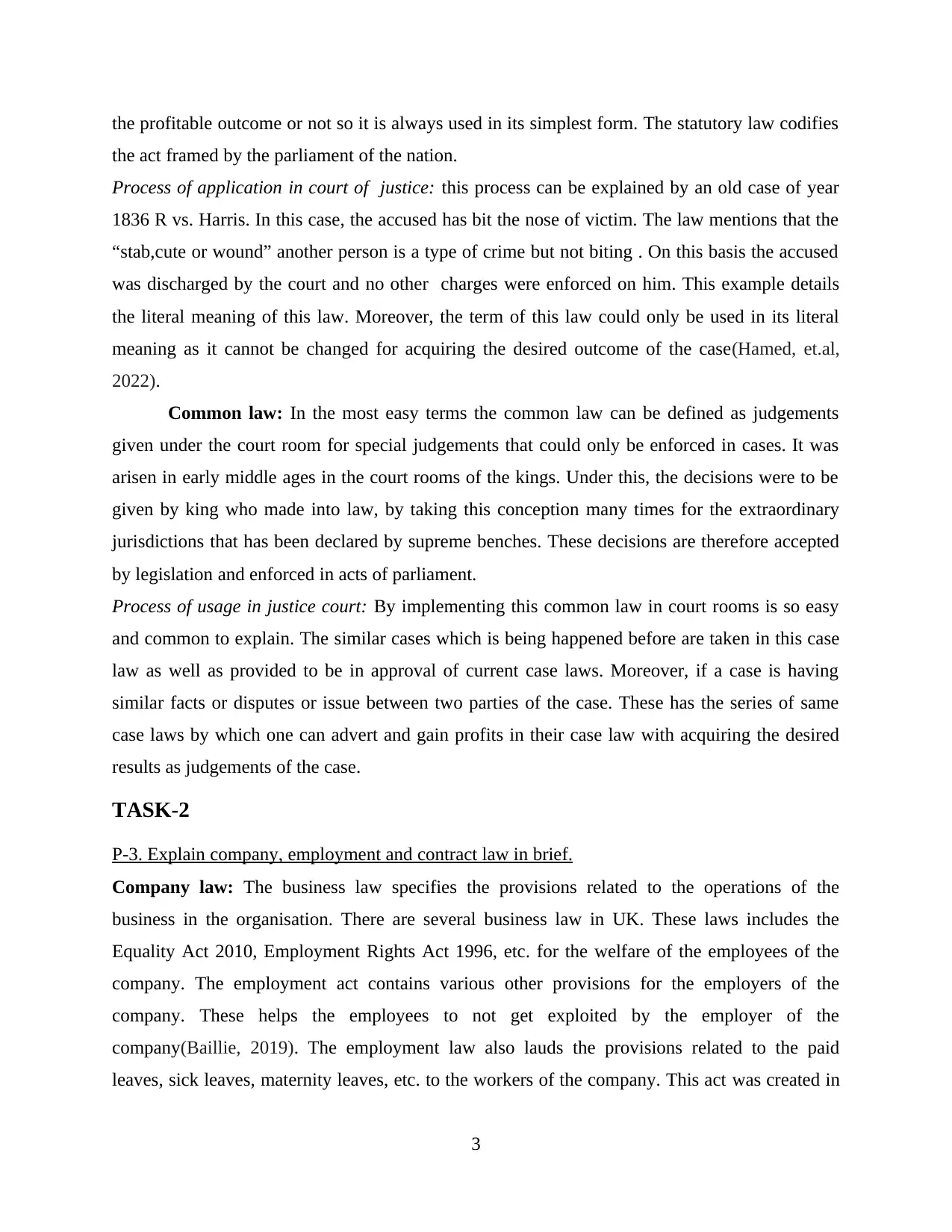
the profitable outcome or not so it is always used in its simplest form. The statutory law codifies
the act framed by the parliament of the nation.
Process of application in court of justice: this process can be explained by an old case of year
1836 R vs. Harris. In this case, the accused has bit the nose of victim. The law mentions that the
“stab,cute or wound” another person is a type of crime but not biting . On this basis the accused
was discharged by the court and no other charges were enforced on him. This example details
the literal meaning of this law. Moreover, the term of this law could only be used in its literal
meaning as it cannot be changed for acquiring the desired outcome of the case(Hamed, et.al,
2022).
Common law: In the most easy terms the common law can be defined as judgements
given under the court room for special judgements that could only be enforced in cases. It was
arisen in early middle ages in the court rooms of the kings. Under this, the decisions were to be
given by king who made into law, by taking this conception many times for the extraordinary
jurisdictions that has been declared by supreme benches. These decisions are therefore accepted
by legislation and enforced in acts of parliament.
Process of usage in justice court: By implementing this common law in court rooms is so easy
and common to explain. The similar cases which is being happened before are taken in this case
law as well as provided to be in approval of current case laws. Moreover, if a case is having
similar facts or disputes or issue between two parties of the case. These has the series of same
case laws by which one can advert and gain profits in their case law with acquiring the desired
results as judgements of the case.
TASK-2
P-3. Explain company, employment and contract law in brief.
Company law: The business law specifies the provisions related to the operations of the
business in the organisation. There are several business law in UK. These laws includes the
Equality Act 2010, Employment Rights Act 1996, etc. for the welfare of the employees of the
company. The employment act contains various other provisions for the employers of the
company. These helps the employees to not get exploited by the employer of the
company(Baillie, 2019). The employment law also lauds the provisions related to the paid
leaves, sick leaves, maternity leaves, etc. to the workers of the company. This act was created in
3
the act framed by the parliament of the nation.
Process of application in court of justice: this process can be explained by an old case of year
1836 R vs. Harris. In this case, the accused has bit the nose of victim. The law mentions that the
“stab,cute or wound” another person is a type of crime but not biting . On this basis the accused
was discharged by the court and no other charges were enforced on him. This example details
the literal meaning of this law. Moreover, the term of this law could only be used in its literal
meaning as it cannot be changed for acquiring the desired outcome of the case(Hamed, et.al,
2022).
Common law: In the most easy terms the common law can be defined as judgements
given under the court room for special judgements that could only be enforced in cases. It was
arisen in early middle ages in the court rooms of the kings. Under this, the decisions were to be
given by king who made into law, by taking this conception many times for the extraordinary
jurisdictions that has been declared by supreme benches. These decisions are therefore accepted
by legislation and enforced in acts of parliament.
Process of usage in justice court: By implementing this common law in court rooms is so easy
and common to explain. The similar cases which is being happened before are taken in this case
law as well as provided to be in approval of current case laws. Moreover, if a case is having
similar facts or disputes or issue between two parties of the case. These has the series of same
case laws by which one can advert and gain profits in their case law with acquiring the desired
results as judgements of the case.
TASK-2
P-3. Explain company, employment and contract law in brief.
Company law: The business law specifies the provisions related to the operations of the
business in the organisation. There are several business law in UK. These laws includes the
Equality Act 2010, Employment Rights Act 1996, etc. for the welfare of the employees of the
company. The employment act contains various other provisions for the employers of the
company. These helps the employees to not get exploited by the employer of the
company(Baillie, 2019). The employment law also lauds the provisions related to the paid
leaves, sick leaves, maternity leaves, etc. to the workers of the company. This act was created in
3
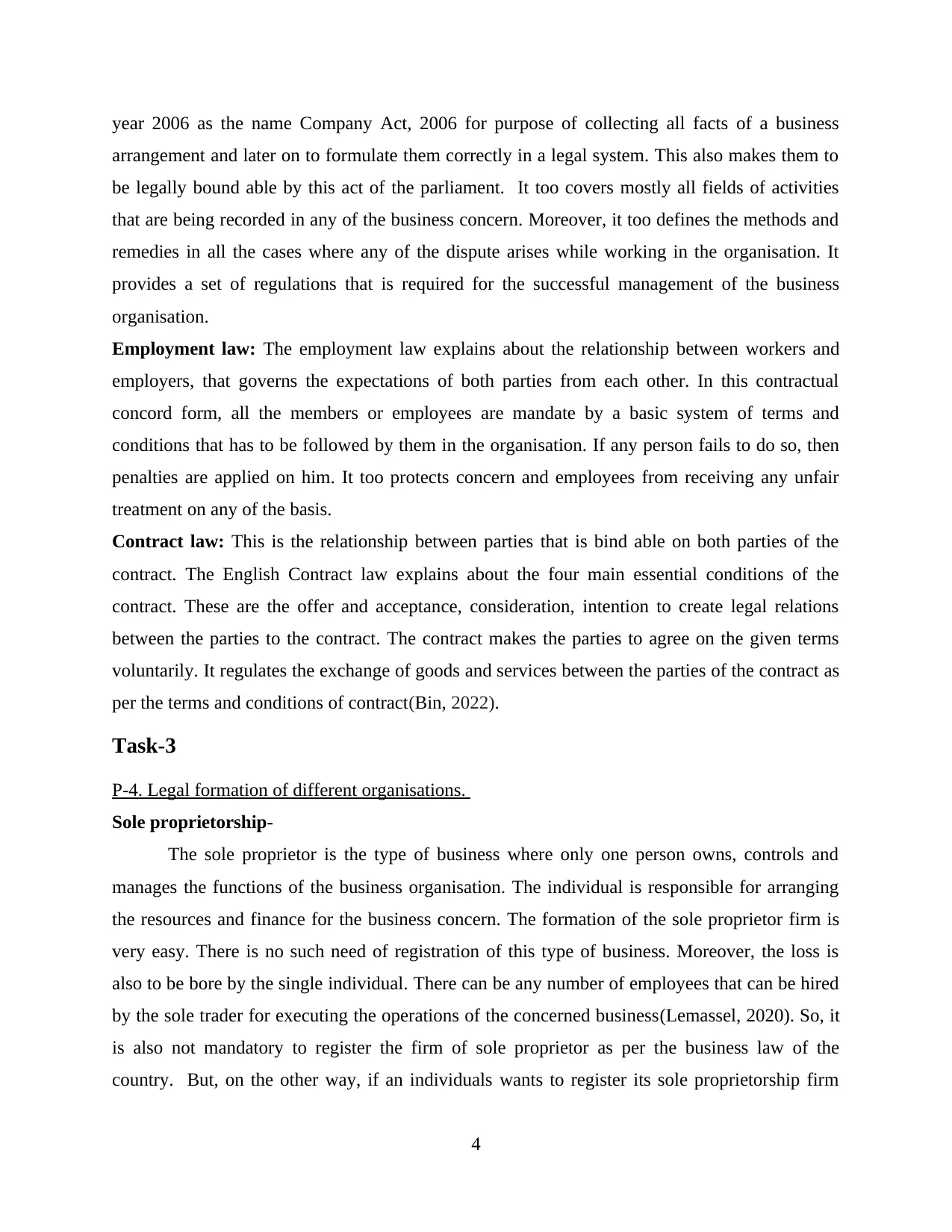
year 2006 as the name Company Act, 2006 for purpose of collecting all facts of a business
arrangement and later on to formulate them correctly in a legal system. This also makes them to
be legally bound able by this act of the parliament. It too covers mostly all fields of activities
that are being recorded in any of the business concern. Moreover, it too defines the methods and
remedies in all the cases where any of the dispute arises while working in the organisation. It
provides a set of regulations that is required for the successful management of the business
organisation.
Employment law: The employment law explains about the relationship between workers and
employers, that governs the expectations of both parties from each other. In this contractual
concord form, all the members or employees are mandate by a basic system of terms and
conditions that has to be followed by them in the organisation. If any person fails to do so, then
penalties are applied on him. It too protects concern and employees from receiving any unfair
treatment on any of the basis.
Contract law: This is the relationship between parties that is bind able on both parties of the
contract. The English Contract law explains about the four main essential conditions of the
contract. These are the offer and acceptance, consideration, intention to create legal relations
between the parties to the contract. The contract makes the parties to agree on the given terms
voluntarily. It regulates the exchange of goods and services between the parties of the contract as
per the terms and conditions of contract(Bin, 2022).
Task-3
P-4. Legal formation of different organisations.
Sole proprietorship-
The sole proprietor is the type of business where only one person owns, controls and
manages the functions of the business organisation. The individual is responsible for arranging
the resources and finance for the business concern. The formation of the sole proprietor firm is
very easy. There is no such need of registration of this type of business. Moreover, the loss is
also to be bore by the single individual. There can be any number of employees that can be hired
by the sole trader for executing the operations of the concerned business(Lemassel, 2020). So, it
is also not mandatory to register the firm of sole proprietor as per the business law of the
country. But, on the other way, if an individuals wants to register its sole proprietorship firm
4
arrangement and later on to formulate them correctly in a legal system. This also makes them to
be legally bound able by this act of the parliament. It too covers mostly all fields of activities
that are being recorded in any of the business concern. Moreover, it too defines the methods and
remedies in all the cases where any of the dispute arises while working in the organisation. It
provides a set of regulations that is required for the successful management of the business
organisation.
Employment law: The employment law explains about the relationship between workers and
employers, that governs the expectations of both parties from each other. In this contractual
concord form, all the members or employees are mandate by a basic system of terms and
conditions that has to be followed by them in the organisation. If any person fails to do so, then
penalties are applied on him. It too protects concern and employees from receiving any unfair
treatment on any of the basis.
Contract law: This is the relationship between parties that is bind able on both parties of the
contract. The English Contract law explains about the four main essential conditions of the
contract. These are the offer and acceptance, consideration, intention to create legal relations
between the parties to the contract. The contract makes the parties to agree on the given terms
voluntarily. It regulates the exchange of goods and services between the parties of the contract as
per the terms and conditions of contract(Bin, 2022).
Task-3
P-4. Legal formation of different organisations.
Sole proprietorship-
The sole proprietor is the type of business where only one person owns, controls and
manages the functions of the business organisation. The individual is responsible for arranging
the resources and finance for the business concern. The formation of the sole proprietor firm is
very easy. There is no such need of registration of this type of business. Moreover, the loss is
also to be bore by the single individual. There can be any number of employees that can be hired
by the sole trader for executing the operations of the concerned business(Lemassel, 2020). So, it
is also not mandatory to register the firm of sole proprietor as per the business law of the
country. But, on the other way, if an individuals wants to register its sole proprietorship firm
4
⊘ This is a preview!⊘
Do you want full access?
Subscribe today to unlock all pages.

Trusted by 1+ million students worldwide
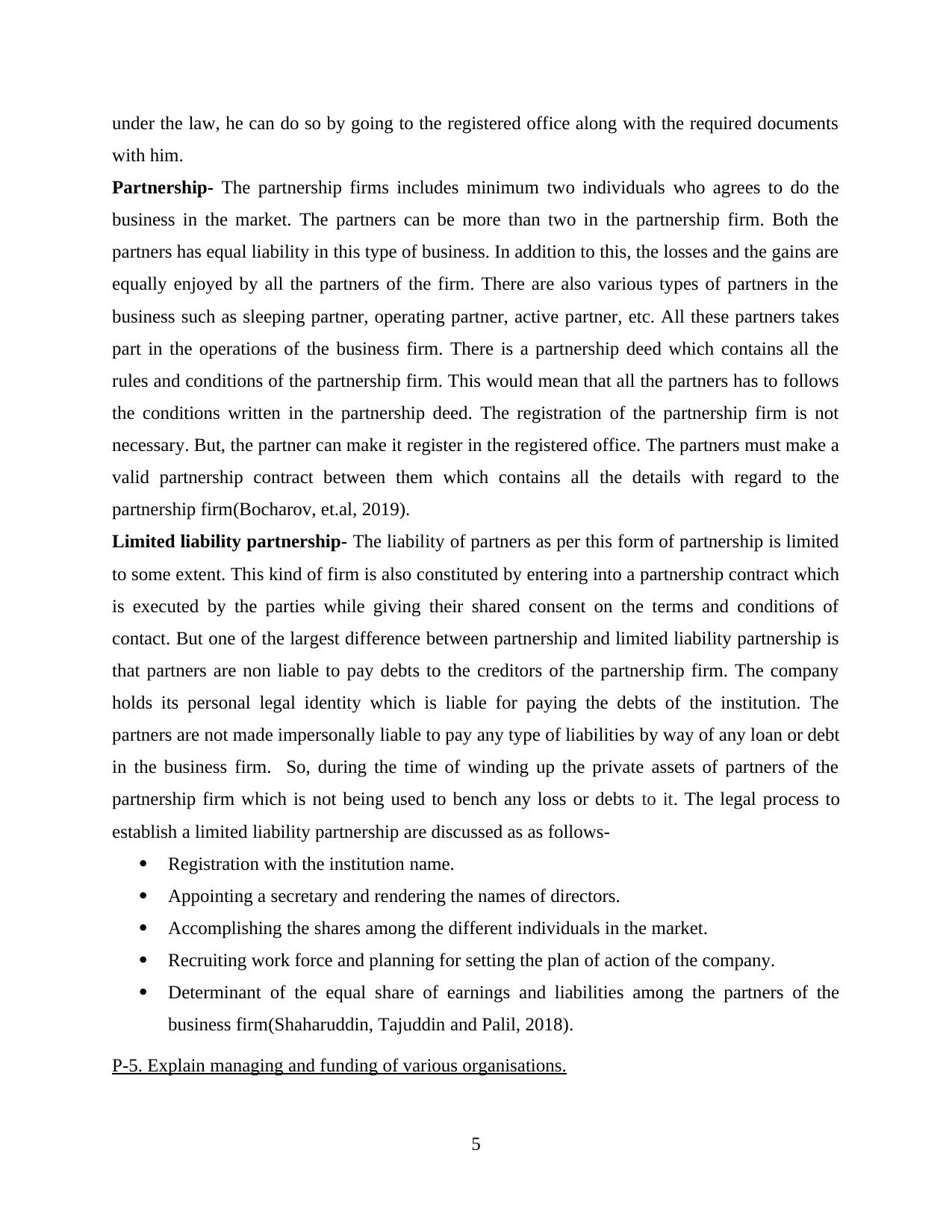
under the law, he can do so by going to the registered office along with the required documents
with him.
Partnership- The partnership firms includes minimum two individuals who agrees to do the
business in the market. The partners can be more than two in the partnership firm. Both the
partners has equal liability in this type of business. In addition to this, the losses and the gains are
equally enjoyed by all the partners of the firm. There are also various types of partners in the
business such as sleeping partner, operating partner, active partner, etc. All these partners takes
part in the operations of the business firm. There is a partnership deed which contains all the
rules and conditions of the partnership firm. This would mean that all the partners has to follows
the conditions written in the partnership deed. The registration of the partnership firm is not
necessary. But, the partner can make it register in the registered office. The partners must make a
valid partnership contract between them which contains all the details with regard to the
partnership firm(Bocharov, et.al, 2019).
Limited liability partnership- The liability of partners as per this form of partnership is limited
to some extent. This kind of firm is also constituted by entering into a partnership contract which
is executed by the parties while giving their shared consent on the terms and conditions of
contact. But one of the largest difference between partnership and limited liability partnership is
that partners are non liable to pay debts to the creditors of the partnership firm. The company
holds its personal legal identity which is liable for paying the debts of the institution. The
partners are not made impersonally liable to pay any type of liabilities by way of any loan or debt
in the business firm. So, during the time of winding up the private assets of partners of the
partnership firm which is not being used to bench any loss or debts to it. The legal process to
establish a limited liability partnership are discussed as as follows-
Registration with the institution name.
Appointing a secretary and rendering the names of directors.
Accomplishing the shares among the different individuals in the market.
Recruiting work force and planning for setting the plan of action of the company.
Determinant of the equal share of earnings and liabilities among the partners of the
business firm(Shaharuddin, Tajuddin and Palil, 2018).
P-5. Explain managing and funding of various organisations.
5
with him.
Partnership- The partnership firms includes minimum two individuals who agrees to do the
business in the market. The partners can be more than two in the partnership firm. Both the
partners has equal liability in this type of business. In addition to this, the losses and the gains are
equally enjoyed by all the partners of the firm. There are also various types of partners in the
business such as sleeping partner, operating partner, active partner, etc. All these partners takes
part in the operations of the business firm. There is a partnership deed which contains all the
rules and conditions of the partnership firm. This would mean that all the partners has to follows
the conditions written in the partnership deed. The registration of the partnership firm is not
necessary. But, the partner can make it register in the registered office. The partners must make a
valid partnership contract between them which contains all the details with regard to the
partnership firm(Bocharov, et.al, 2019).
Limited liability partnership- The liability of partners as per this form of partnership is limited
to some extent. This kind of firm is also constituted by entering into a partnership contract which
is executed by the parties while giving their shared consent on the terms and conditions of
contact. But one of the largest difference between partnership and limited liability partnership is
that partners are non liable to pay debts to the creditors of the partnership firm. The company
holds its personal legal identity which is liable for paying the debts of the institution. The
partners are not made impersonally liable to pay any type of liabilities by way of any loan or debt
in the business firm. So, during the time of winding up the private assets of partners of the
partnership firm which is not being used to bench any loss or debts to it. The legal process to
establish a limited liability partnership are discussed as as follows-
Registration with the institution name.
Appointing a secretary and rendering the names of directors.
Accomplishing the shares among the different individuals in the market.
Recruiting work force and planning for setting the plan of action of the company.
Determinant of the equal share of earnings and liabilities among the partners of the
business firm(Shaharuddin, Tajuddin and Palil, 2018).
P-5. Explain managing and funding of various organisations.
5
Paraphrase This Document
Need a fresh take? Get an instant paraphrase of this document with our AI Paraphraser
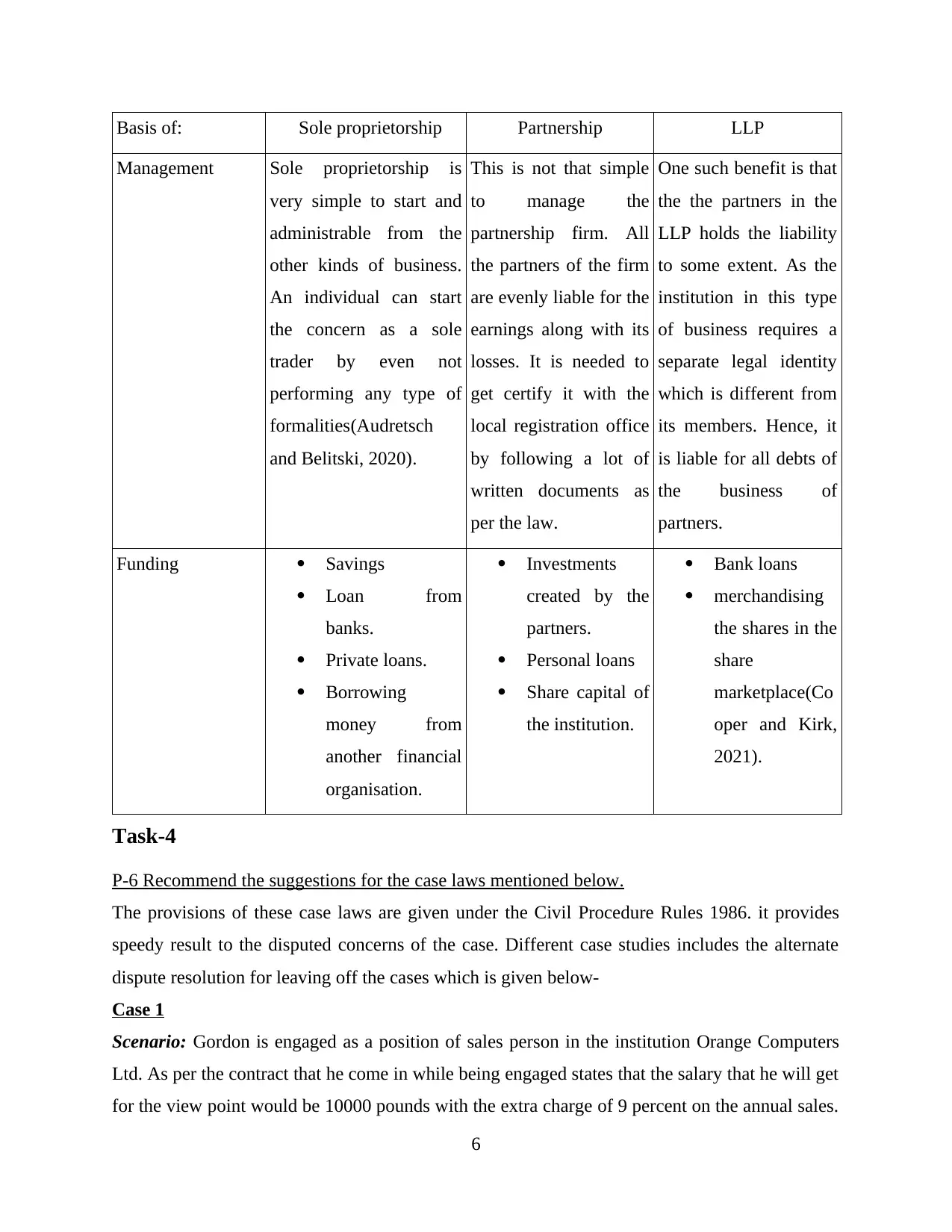
Basis of: Sole proprietorship Partnership LLP
Management Sole proprietorship is
very simple to start and
administrable from the
other kinds of business.
An individual can start
the concern as a sole
trader by even not
performing any type of
formalities(Audretsch
and Belitski, 2020).
This is not that simple
to manage the
partnership firm. All
the partners of the firm
are evenly liable for the
earnings along with its
losses. It is needed to
get certify it with the
local registration office
by following a lot of
written documents as
per the law.
One such benefit is that
the the partners in the
LLP holds the liability
to some extent. As the
institution in this type
of business requires a
separate legal identity
which is different from
its members. Hence, it
is liable for all debts of
the business of
partners.
Funding Savings
Loan from
banks.
Private loans.
Borrowing
money from
another financial
organisation.
Investments
created by the
partners.
Personal loans
Share capital of
the institution.
Bank loans
merchandising
the shares in the
share
marketplace(Co
oper and Kirk,
2021).
Task-4
P-6 Recommend the suggestions for the case laws mentioned below.
The provisions of these case laws are given under the Civil Procedure Rules 1986. it provides
speedy result to the disputed concerns of the case. Different case studies includes the alternate
dispute resolution for leaving off the cases which is given below-
Case 1
Scenario: Gordon is engaged as a position of sales person in the institution Orange Computers
Ltd. As per the contract that he come in while being engaged states that the salary that he will get
for the view point would be 10000 pounds with the extra charge of 9 percent on the annual sales.
6
Management Sole proprietorship is
very simple to start and
administrable from the
other kinds of business.
An individual can start
the concern as a sole
trader by even not
performing any type of
formalities(Audretsch
and Belitski, 2020).
This is not that simple
to manage the
partnership firm. All
the partners of the firm
are evenly liable for the
earnings along with its
losses. It is needed to
get certify it with the
local registration office
by following a lot of
written documents as
per the law.
One such benefit is that
the the partners in the
LLP holds the liability
to some extent. As the
institution in this type
of business requires a
separate legal identity
which is different from
its members. Hence, it
is liable for all debts of
the business of
partners.
Funding Savings
Loan from
banks.
Private loans.
Borrowing
money from
another financial
organisation.
Investments
created by the
partners.
Personal loans
Share capital of
the institution.
Bank loans
merchandising
the shares in the
share
marketplace(Co
oper and Kirk,
2021).
Task-4
P-6 Recommend the suggestions for the case laws mentioned below.
The provisions of these case laws are given under the Civil Procedure Rules 1986. it provides
speedy result to the disputed concerns of the case. Different case studies includes the alternate
dispute resolution for leaving off the cases which is given below-
Case 1
Scenario: Gordon is engaged as a position of sales person in the institution Orange Computers
Ltd. As per the contract that he come in while being engaged states that the salary that he will get
for the view point would be 10000 pounds with the extra charge of 9 percent on the annual sales.
6
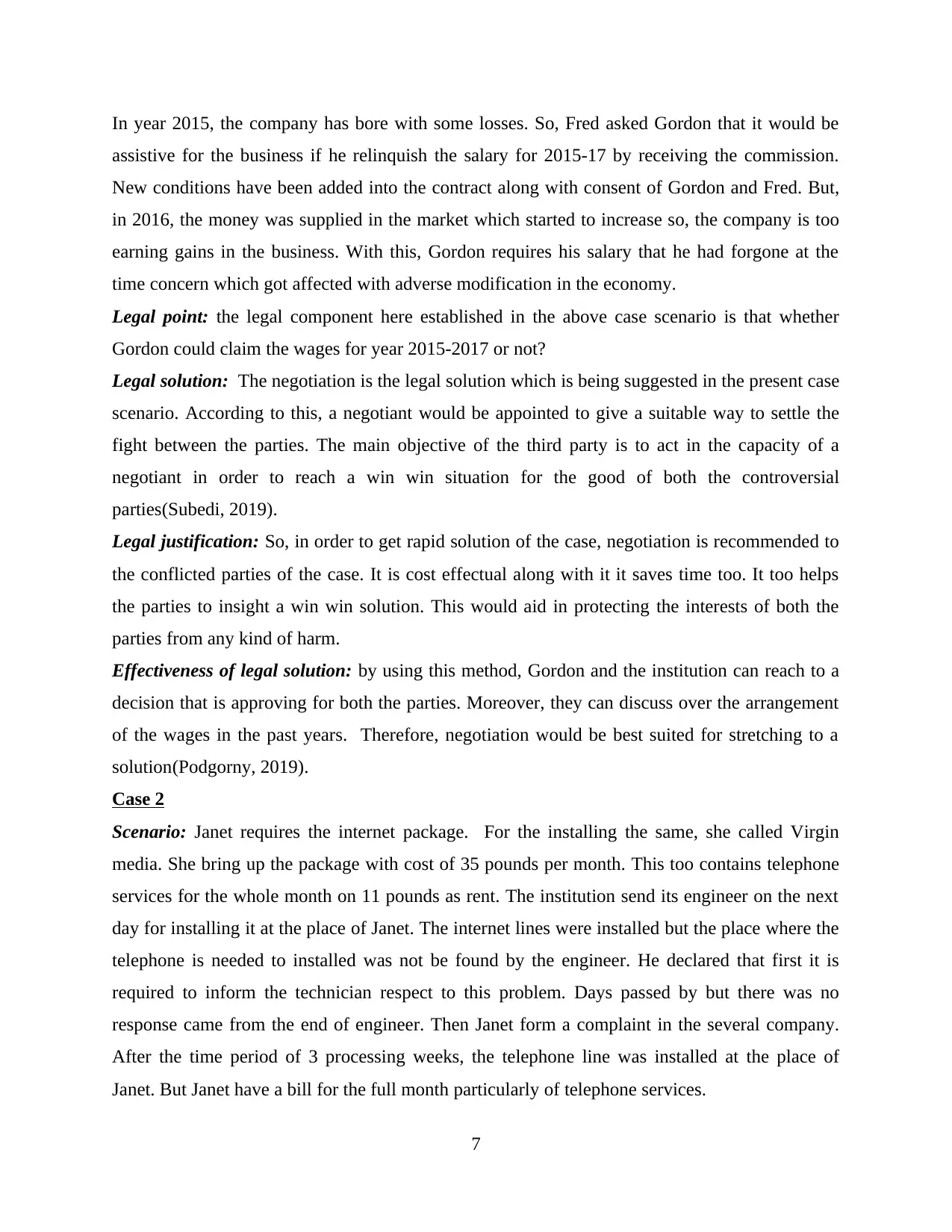
In year 2015, the company has bore with some losses. So, Fred asked Gordon that it would be
assistive for the business if he relinquish the salary for 2015-17 by receiving the commission.
New conditions have been added into the contract along with consent of Gordon and Fred. But,
in 2016, the money was supplied in the market which started to increase so, the company is too
earning gains in the business. With this, Gordon requires his salary that he had forgone at the
time concern which got affected with adverse modification in the economy.
Legal point: the legal component here established in the above case scenario is that whether
Gordon could claim the wages for year 2015-2017 or not?
Legal solution: The negotiation is the legal solution which is being suggested in the present case
scenario. According to this, a negotiant would be appointed to give a suitable way to settle the
fight between the parties. The main objective of the third party is to act in the capacity of a
negotiant in order to reach a win win situation for the good of both the controversial
parties(Subedi, 2019).
Legal justification: So, in order to get rapid solution of the case, negotiation is recommended to
the conflicted parties of the case. It is cost effectual along with it it saves time too. It too helps
the parties to insight a win win solution. This would aid in protecting the interests of both the
parties from any kind of harm.
Effectiveness of legal solution: by using this method, Gordon and the institution can reach to a
decision that is approving for both the parties. Moreover, they can discuss over the arrangement
of the wages in the past years. Therefore, negotiation would be best suited for stretching to a
solution(Podgorny, 2019).
Case 2
Scenario: Janet requires the internet package. For the installing the same, she called Virgin
media. She bring up the package with cost of 35 pounds per month. This too contains telephone
services for the whole month on 11 pounds as rent. The institution send its engineer on the next
day for installing it at the place of Janet. The internet lines were installed but the place where the
telephone is needed to installed was not be found by the engineer. He declared that first it is
required to inform the technician respect to this problem. Days passed by but there was no
response came from the end of engineer. Then Janet form a complaint in the several company.
After the time period of 3 processing weeks, the telephone line was installed at the place of
Janet. But Janet have a bill for the full month particularly of telephone services.
7
assistive for the business if he relinquish the salary for 2015-17 by receiving the commission.
New conditions have been added into the contract along with consent of Gordon and Fred. But,
in 2016, the money was supplied in the market which started to increase so, the company is too
earning gains in the business. With this, Gordon requires his salary that he had forgone at the
time concern which got affected with adverse modification in the economy.
Legal point: the legal component here established in the above case scenario is that whether
Gordon could claim the wages for year 2015-2017 or not?
Legal solution: The negotiation is the legal solution which is being suggested in the present case
scenario. According to this, a negotiant would be appointed to give a suitable way to settle the
fight between the parties. The main objective of the third party is to act in the capacity of a
negotiant in order to reach a win win situation for the good of both the controversial
parties(Subedi, 2019).
Legal justification: So, in order to get rapid solution of the case, negotiation is recommended to
the conflicted parties of the case. It is cost effectual along with it it saves time too. It too helps
the parties to insight a win win solution. This would aid in protecting the interests of both the
parties from any kind of harm.
Effectiveness of legal solution: by using this method, Gordon and the institution can reach to a
decision that is approving for both the parties. Moreover, they can discuss over the arrangement
of the wages in the past years. Therefore, negotiation would be best suited for stretching to a
solution(Podgorny, 2019).
Case 2
Scenario: Janet requires the internet package. For the installing the same, she called Virgin
media. She bring up the package with cost of 35 pounds per month. This too contains telephone
services for the whole month on 11 pounds as rent. The institution send its engineer on the next
day for installing it at the place of Janet. The internet lines were installed but the place where the
telephone is needed to installed was not be found by the engineer. He declared that first it is
required to inform the technician respect to this problem. Days passed by but there was no
response came from the end of engineer. Then Janet form a complaint in the several company.
After the time period of 3 processing weeks, the telephone line was installed at the place of
Janet. But Janet have a bill for the full month particularly of telephone services.
7
⊘ This is a preview!⊘
Do you want full access?
Subscribe today to unlock all pages.

Trusted by 1+ million students worldwide
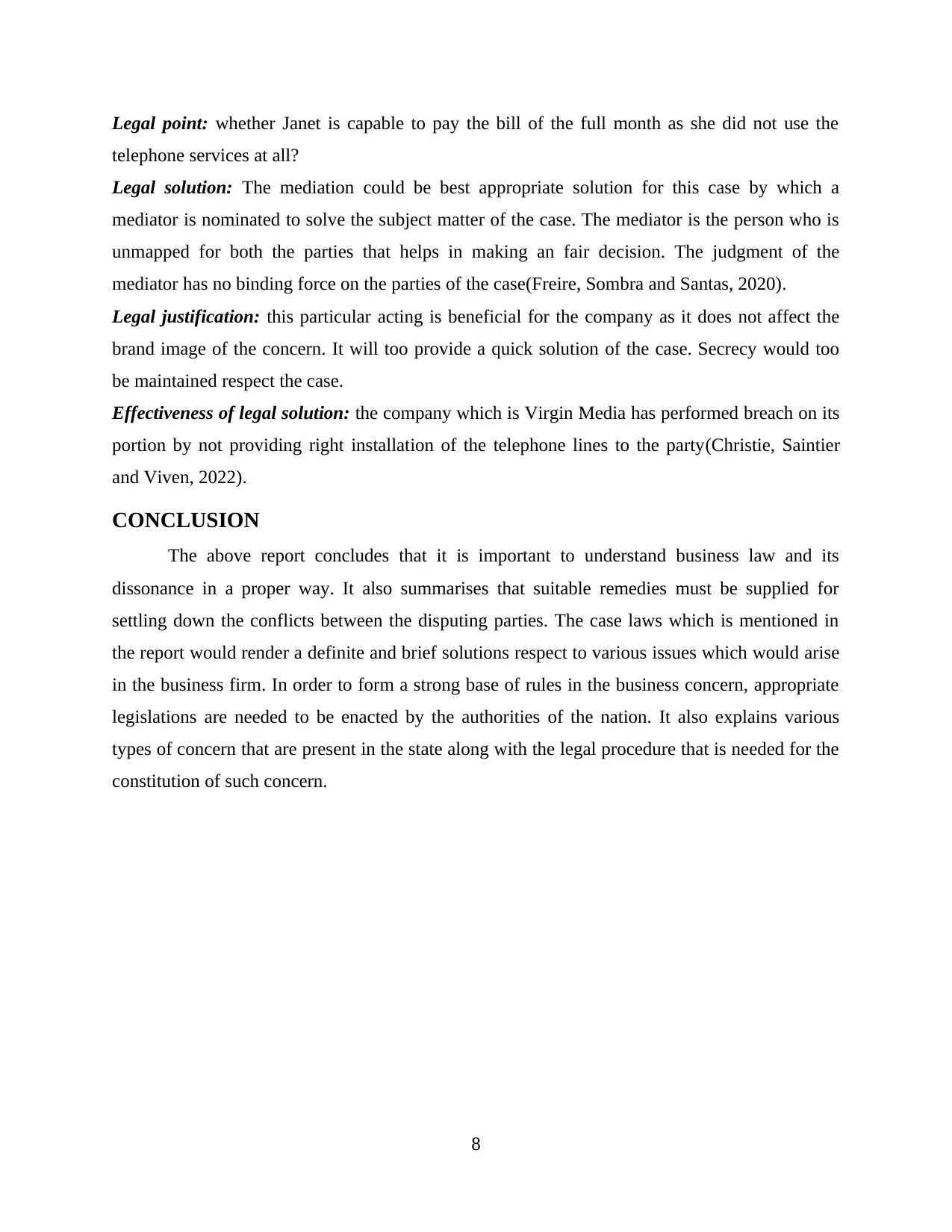
Legal point: whether Janet is capable to pay the bill of the full month as she did not use the
telephone services at all?
Legal solution: The mediation could be best appropriate solution for this case by which a
mediator is nominated to solve the subject matter of the case. The mediator is the person who is
unmapped for both the parties that helps in making an fair decision. The judgment of the
mediator has no binding force on the parties of the case(Freire, Sombra and Santas, 2020).
Legal justification: this particular acting is beneficial for the company as it does not affect the
brand image of the concern. It will too provide a quick solution of the case. Secrecy would too
be maintained respect the case.
Effectiveness of legal solution: the company which is Virgin Media has performed breach on its
portion by not providing right installation of the telephone lines to the party(Christie, Saintier
and Viven, 2022).
CONCLUSION
The above report concludes that it is important to understand business law and its
dissonance in a proper way. It also summarises that suitable remedies must be supplied for
settling down the conflicts between the disputing parties. The case laws which is mentioned in
the report would render a definite and brief solutions respect to various issues which would arise
in the business firm. In order to form a strong base of rules in the business concern, appropriate
legislations are needed to be enacted by the authorities of the nation. It also explains various
types of concern that are present in the state along with the legal procedure that is needed for the
constitution of such concern.
8
telephone services at all?
Legal solution: The mediation could be best appropriate solution for this case by which a
mediator is nominated to solve the subject matter of the case. The mediator is the person who is
unmapped for both the parties that helps in making an fair decision. The judgment of the
mediator has no binding force on the parties of the case(Freire, Sombra and Santas, 2020).
Legal justification: this particular acting is beneficial for the company as it does not affect the
brand image of the concern. It will too provide a quick solution of the case. Secrecy would too
be maintained respect the case.
Effectiveness of legal solution: the company which is Virgin Media has performed breach on its
portion by not providing right installation of the telephone lines to the party(Christie, Saintier
and Viven, 2022).
CONCLUSION
The above report concludes that it is important to understand business law and its
dissonance in a proper way. It also summarises that suitable remedies must be supplied for
settling down the conflicts between the disputing parties. The case laws which is mentioned in
the report would render a definite and brief solutions respect to various issues which would arise
in the business firm. In order to form a strong base of rules in the business concern, appropriate
legislations are needed to be enacted by the authorities of the nation. It also explains various
types of concern that are present in the state along with the legal procedure that is needed for the
constitution of such concern.
8
Paraphrase This Document
Need a fresh take? Get an instant paraphrase of this document with our AI Paraphraser
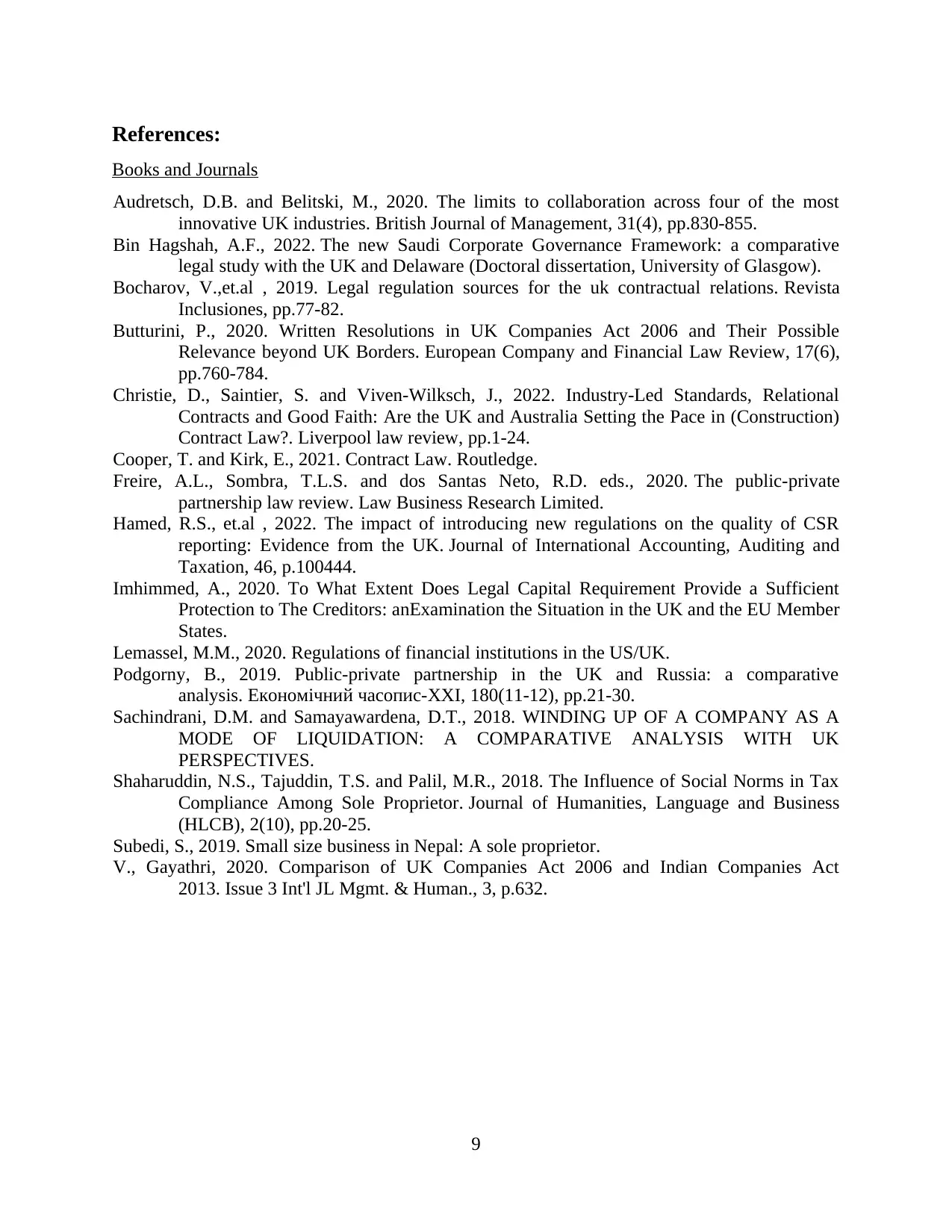
References:
Books and Journals
Audretsch, D.B. and Belitski, M., 2020. The limits to collaboration across four of the most
innovative UK industries. British Journal of Management, 31(4), pp.830-855.
Bin Hagshah, A.F., 2022. The new Saudi Corporate Governance Framework: a comparative
legal study with the UK and Delaware (Doctoral dissertation, University of Glasgow).
Bocharov, V.,et.al , 2019. Legal regulation sources for the uk contractual relations. Revista
Inclusiones, pp.77-82.
Butturini, P., 2020. Written Resolutions in UK Companies Act 2006 and Their Possible
Relevance beyond UK Borders. European Company and Financial Law Review, 17(6),
pp.760-784.
Christie, D., Saintier, S. and Viven-Wilksch, J., 2022. Industry-Led Standards, Relational
Contracts and Good Faith: Are the UK and Australia Setting the Pace in (Construction)
Contract Law?. Liverpool law review, pp.1-24.
Cooper, T. and Kirk, E., 2021. Contract Law. Routledge.
Freire, A.L., Sombra, T.L.S. and dos Santas Neto, R.D. eds., 2020. The public-private
partnership law review. Law Business Research Limited.
Hamed, R.S., et.al , 2022. The impact of introducing new regulations on the quality of CSR
reporting: Evidence from the UK. Journal of International Accounting, Auditing and
Taxation, 46, p.100444.
Imhimmed, A., 2020. To What Extent Does Legal Capital Requirement Provide a Sufficient
Protection to The Creditors: anExamination the Situation in the UK and the EU Member
States.
Lemassel, M.M., 2020. Regulations of financial institutions in the US/UK.
Podgorny, B., 2019. Public-private partnership in the UK and Russia: а comparative
analysis. Економічний часопис-ХХІ, 180(11-12), pp.21-30.
Sachindrani, D.M. and Samayawardena, D.T., 2018. WINDING UP OF A COMPANY AS A
MODE OF LIQUIDATION: A COMPARATIVE ANALYSIS WITH UK
PERSPECTIVES.
Shaharuddin, N.S., Tajuddin, T.S. and Palil, M.R., 2018. The Influence of Social Norms in Tax
Compliance Among Sole Proprietor. Journal of Humanities, Language and Business
(HLCB), 2(10), pp.20-25.
Subedi, S., 2019. Small size business in Nepal: A sole proprietor.
V., Gayathri, 2020. Comparison of UK Companies Act 2006 and Indian Companies Act
2013. Issue 3 Int'l JL Mgmt. & Human., 3, p.632.
9
Books and Journals
Audretsch, D.B. and Belitski, M., 2020. The limits to collaboration across four of the most
innovative UK industries. British Journal of Management, 31(4), pp.830-855.
Bin Hagshah, A.F., 2022. The new Saudi Corporate Governance Framework: a comparative
legal study with the UK and Delaware (Doctoral dissertation, University of Glasgow).
Bocharov, V.,et.al , 2019. Legal regulation sources for the uk contractual relations. Revista
Inclusiones, pp.77-82.
Butturini, P., 2020. Written Resolutions in UK Companies Act 2006 and Their Possible
Relevance beyond UK Borders. European Company and Financial Law Review, 17(6),
pp.760-784.
Christie, D., Saintier, S. and Viven-Wilksch, J., 2022. Industry-Led Standards, Relational
Contracts and Good Faith: Are the UK and Australia Setting the Pace in (Construction)
Contract Law?. Liverpool law review, pp.1-24.
Cooper, T. and Kirk, E., 2021. Contract Law. Routledge.
Freire, A.L., Sombra, T.L.S. and dos Santas Neto, R.D. eds., 2020. The public-private
partnership law review. Law Business Research Limited.
Hamed, R.S., et.al , 2022. The impact of introducing new regulations on the quality of CSR
reporting: Evidence from the UK. Journal of International Accounting, Auditing and
Taxation, 46, p.100444.
Imhimmed, A., 2020. To What Extent Does Legal Capital Requirement Provide a Sufficient
Protection to The Creditors: anExamination the Situation in the UK and the EU Member
States.
Lemassel, M.M., 2020. Regulations of financial institutions in the US/UK.
Podgorny, B., 2019. Public-private partnership in the UK and Russia: а comparative
analysis. Економічний часопис-ХХІ, 180(11-12), pp.21-30.
Sachindrani, D.M. and Samayawardena, D.T., 2018. WINDING UP OF A COMPANY AS A
MODE OF LIQUIDATION: A COMPARATIVE ANALYSIS WITH UK
PERSPECTIVES.
Shaharuddin, N.S., Tajuddin, T.S. and Palil, M.R., 2018. The Influence of Social Norms in Tax
Compliance Among Sole Proprietor. Journal of Humanities, Language and Business
(HLCB), 2(10), pp.20-25.
Subedi, S., 2019. Small size business in Nepal: A sole proprietor.
V., Gayathri, 2020. Comparison of UK Companies Act 2006 and Indian Companies Act
2013. Issue 3 Int'l JL Mgmt. & Human., 3, p.632.
9
1 out of 11
Related Documents
Your All-in-One AI-Powered Toolkit for Academic Success.
+13062052269
info@desklib.com
Available 24*7 on WhatsApp / Email
![[object Object]](/_next/static/media/star-bottom.7253800d.svg)
Unlock your academic potential
Copyright © 2020–2025 A2Z Services. All Rights Reserved. Developed and managed by ZUCOL.


